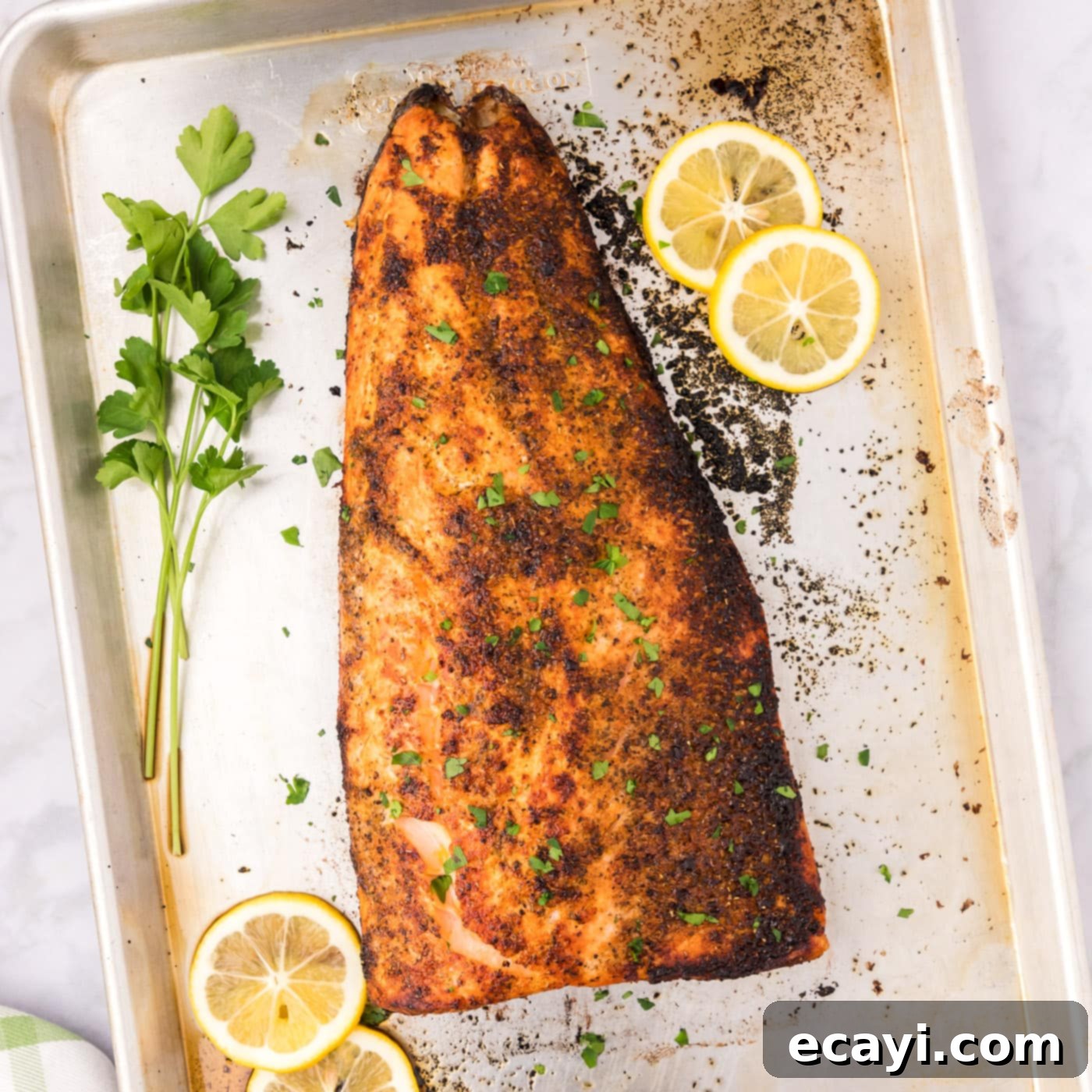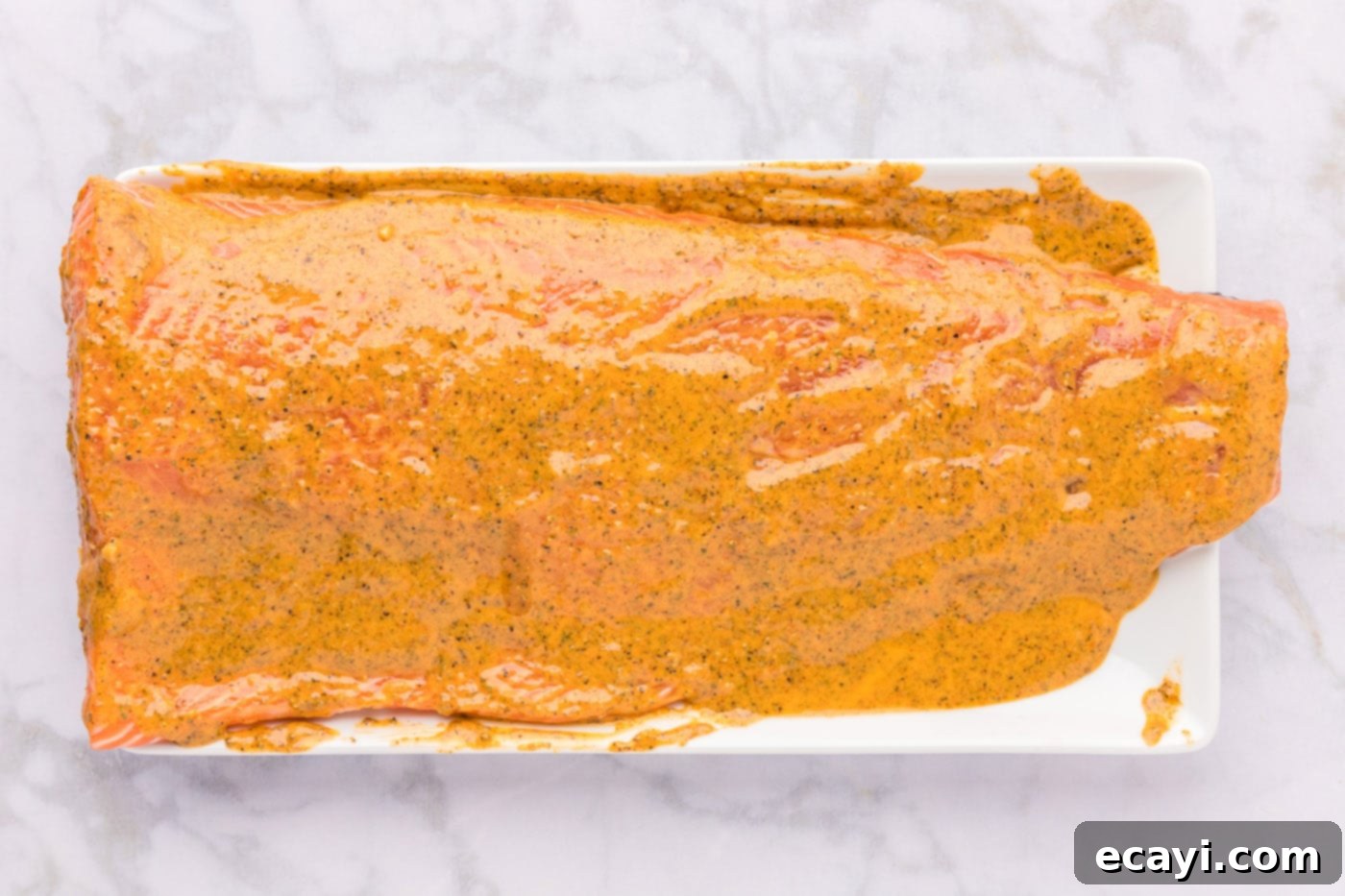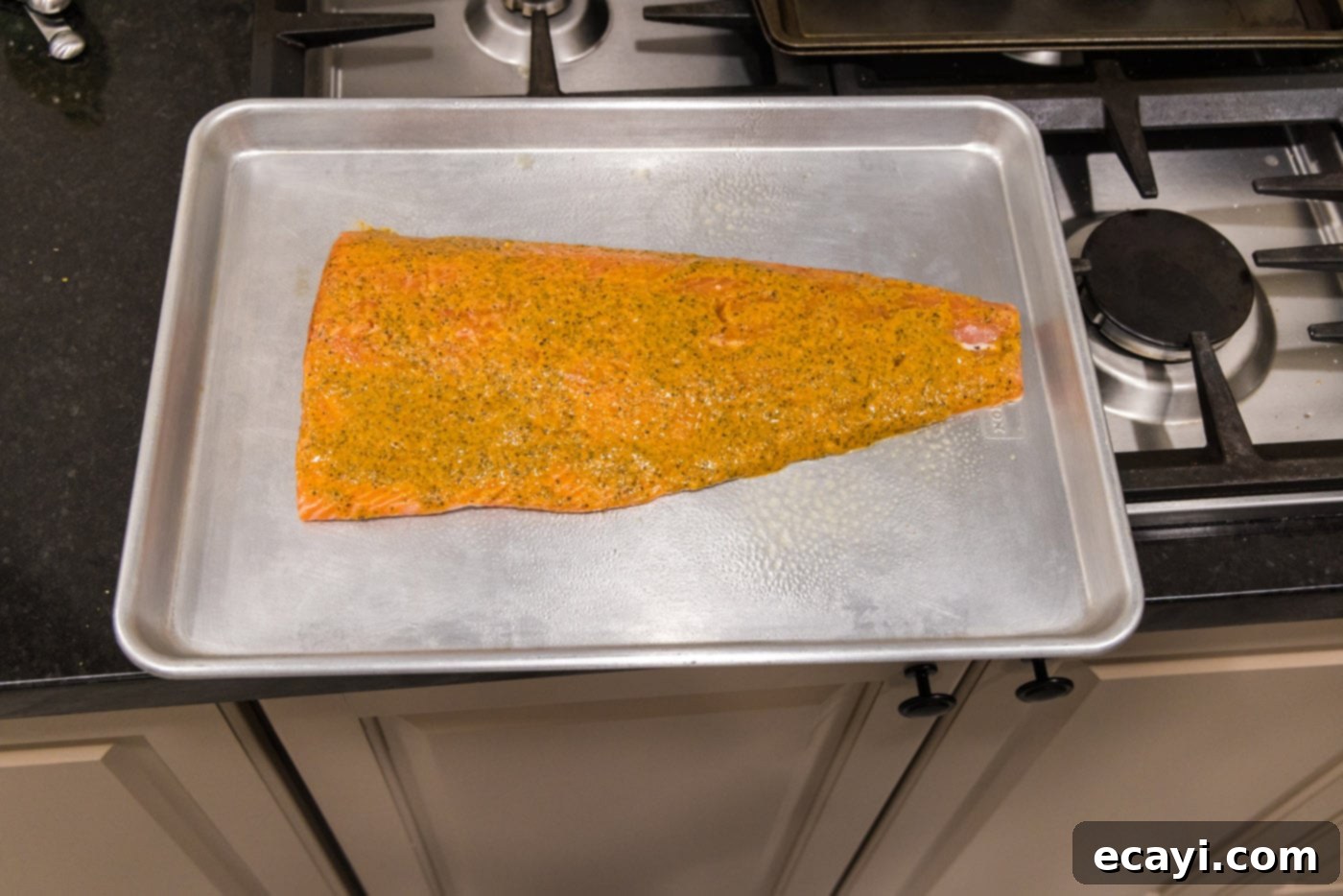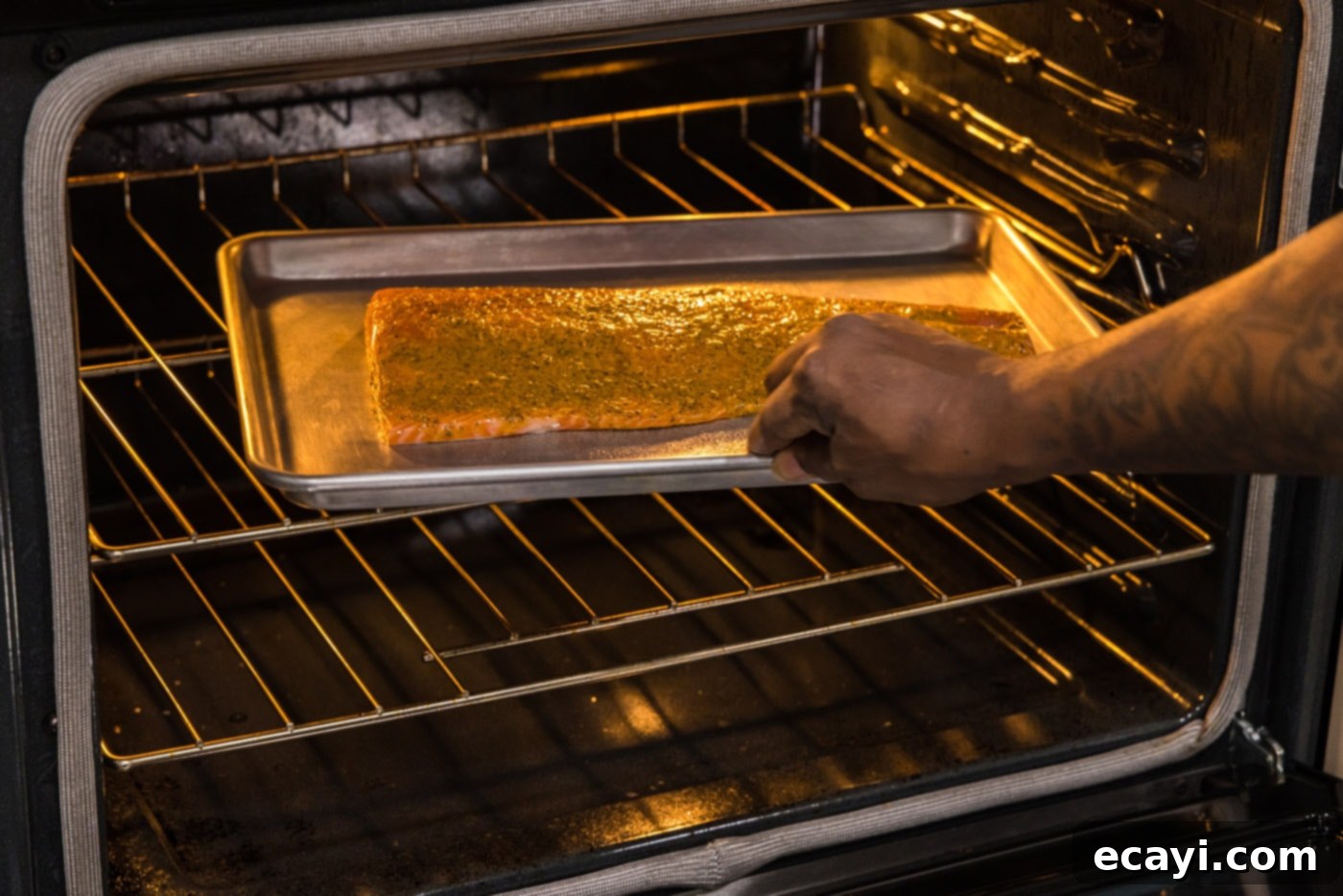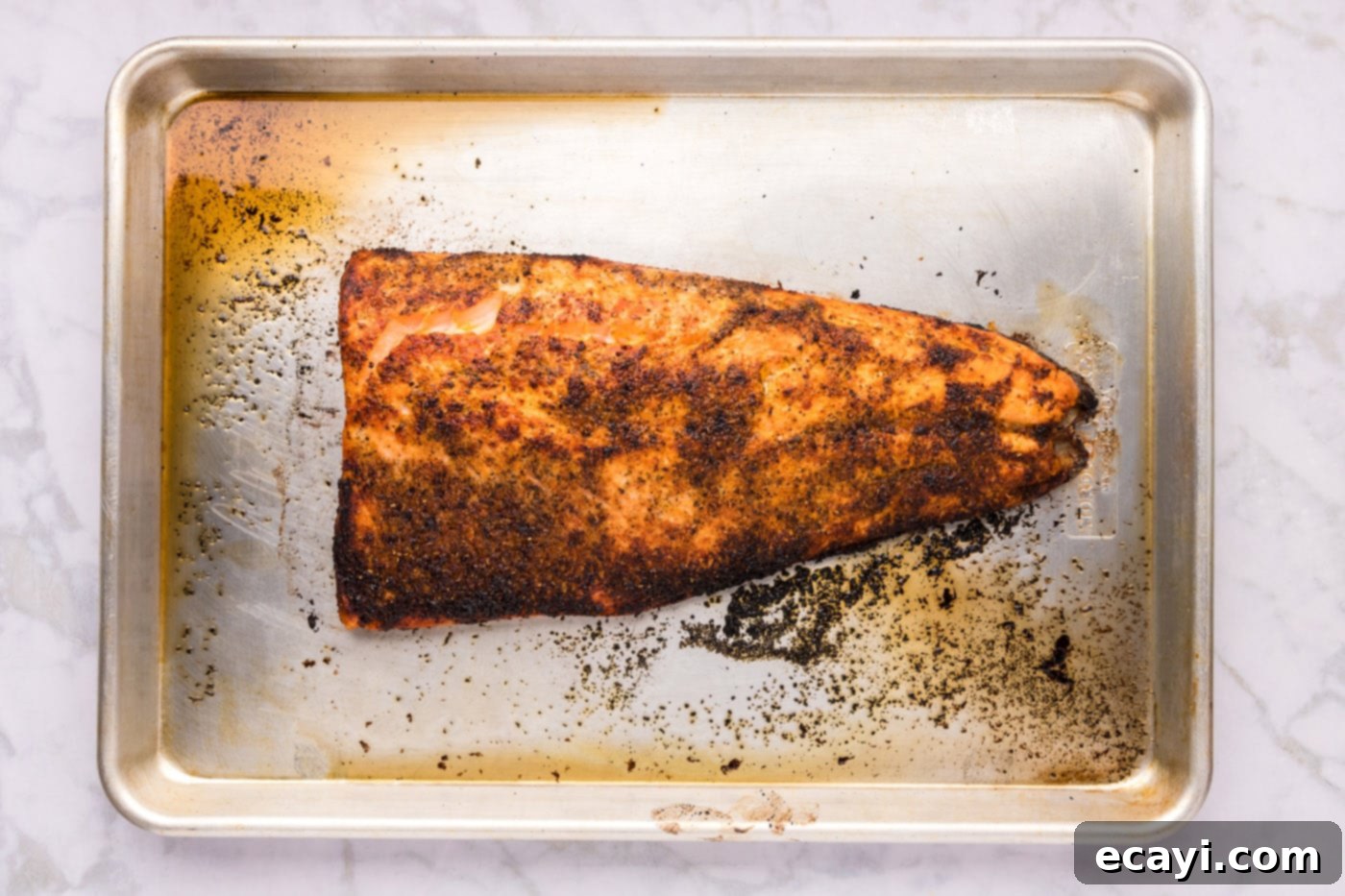Perfectly Broiled Salmon: Achieve Crispy Skin and Flaky Perfection in Minutes
Discover the ultimate method for cooking salmon that delivers both incredible flavor and irresistible texture. Broiled salmon isn’t just remarkably quick and easy; it’s the secret to achieving that coveted, perfectly golden and crispy skin, while the interior remains wonderfully tender and exquisitely flaky. This guide will walk you through creating a restaurant-quality salmon dish right in your own kitchen, promising a delightful culinary experience with minimal effort.
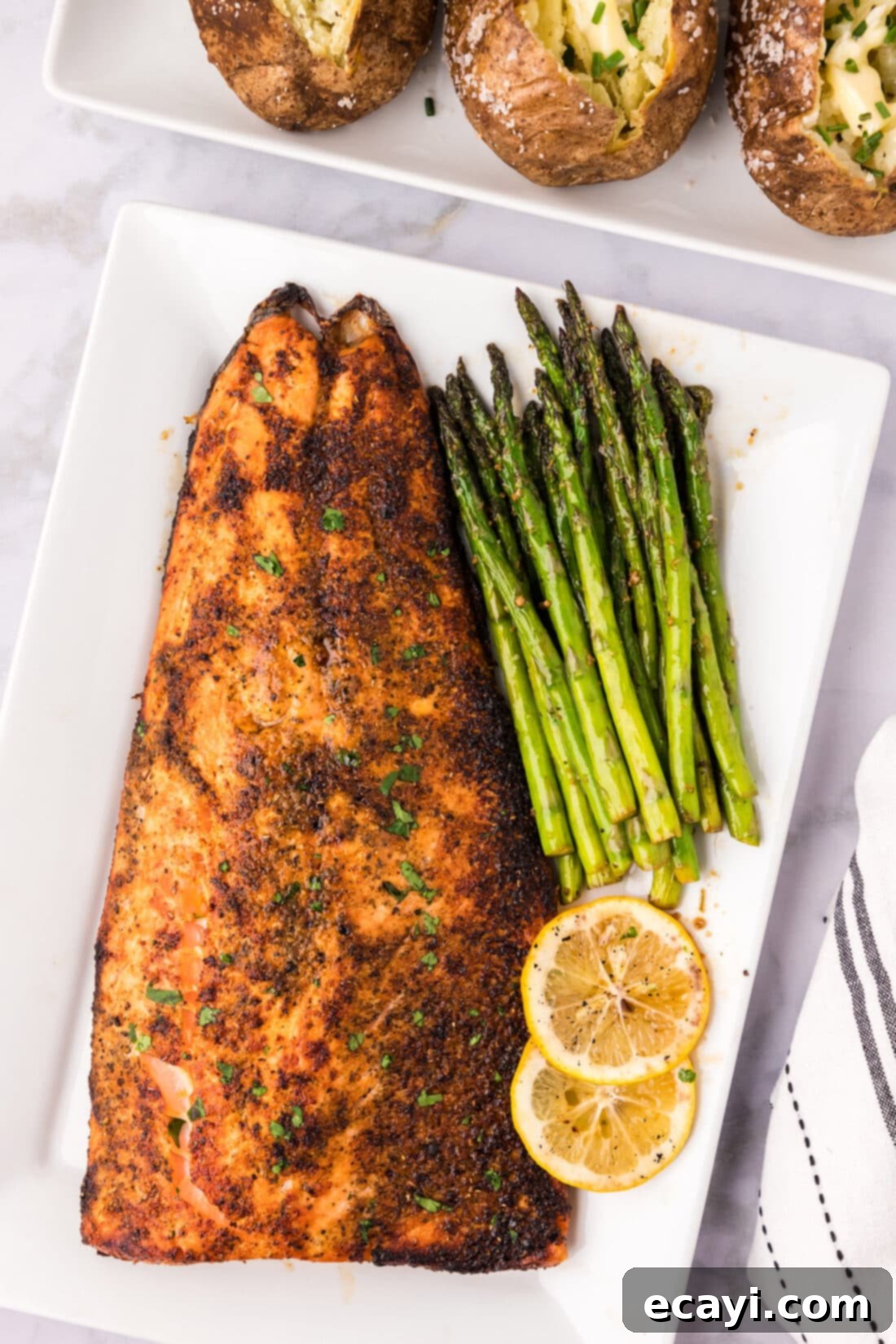
Why This Broiled Salmon Recipe Works Wonders
The magic of broiling salmon lies in its intense, direct heat. Unlike baking or roasting, which use convection heat, broiling utilizes radiant heat from the top element of your oven. This high heat cooks salmon incredibly fast, typically in just 10-13 minutes, creating a magnificent crispy skin that truly crackles with every bite. Simultaneously, the direct heat seals in the natural moisture, leaving the fish succulent and tender on the inside – precisely how salmon should be enjoyed.
Choosing to broil salmon over other cooking methods comes with distinct advantages. The proximity to the powerful heat source ensures a quicker cook time and unparalleled crispiness, making it an ideal choice for busy weeknights or when you crave that extra textural contrast. While baked salmon or roasted salmon also yield tender, flaky fillets, broiling stands out for its ability to deliver an intensely golden, almost caramelized finish on the skin. This cooking method is truly a preference for those who prioritize speed, a beautifully crisp exterior, and a perfectly cooked, moist interior, enhancing the natural rich flavors of the salmon. Plus, salmon is packed with omega-3 fatty acids, making this quick and delicious meal a healthy choice for any day.
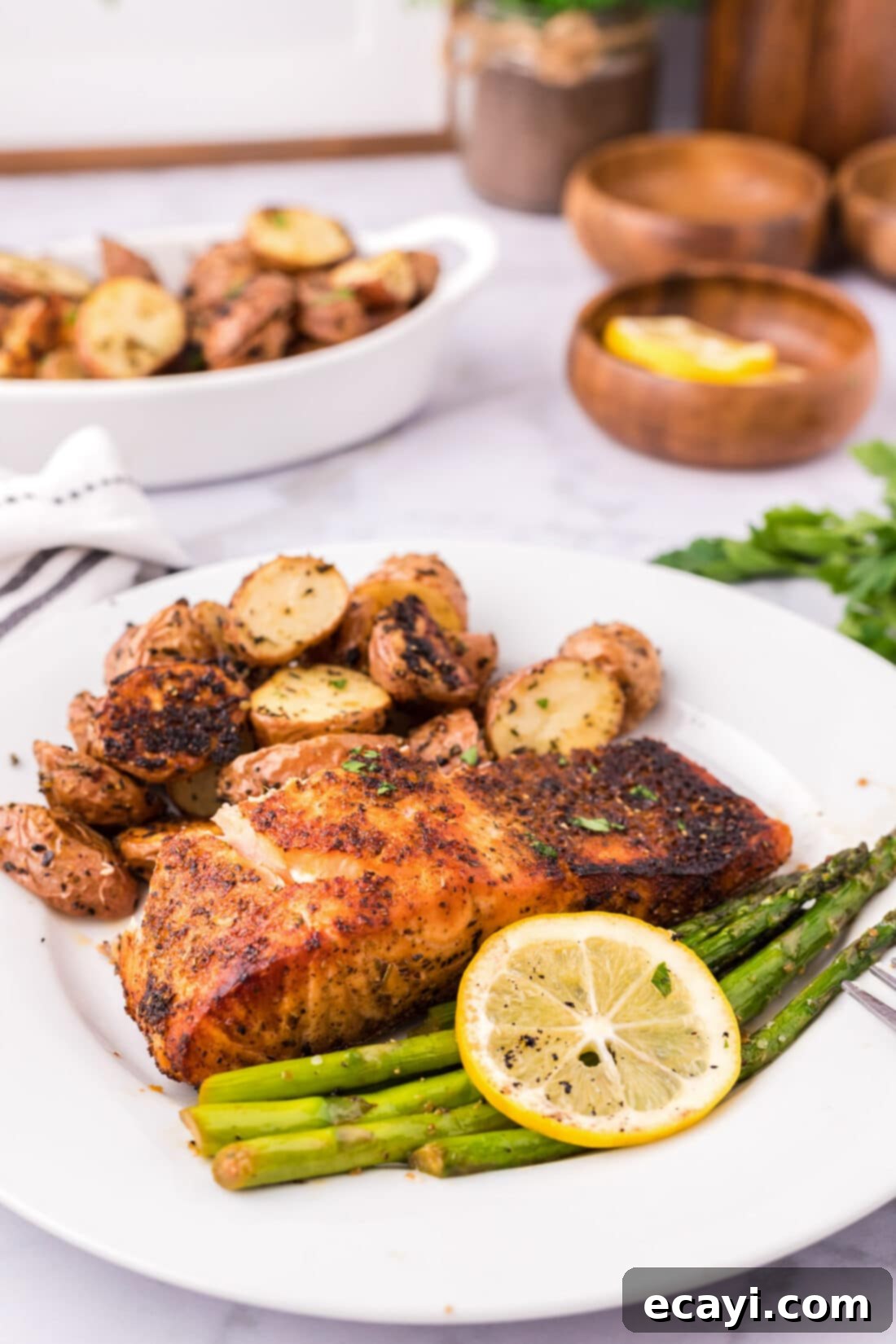
Essential Ingredients for Your Broiled Salmon
Crafting delicious broiled salmon requires just a few key ingredients. The star, of course, is a high-quality salmon fillet, complemented by a flavorful marinade or simple seasonings. You’ll find the precise measurements and detailed instructions in the printable recipe card towards the end of this post. Here’s a quick overview of what you’ll need to prepare this fantastic dish:
- **Salmon:** A fresh, center-cut salmon fillet with the skin on is highly recommended for the best crispy results.
- **Marinade:** Our signature salmon marinade adds a burst of flavor, but a simple blend of salt, pepper, and lemon juice also works wonders.
- **Cooking Spray:** For preventing sticking and easy cleanup.
Gathering your ingredients beforehand ensures a smooth and enjoyable cooking process. Remember, the quality of your salmon makes a big difference in the final taste and texture!
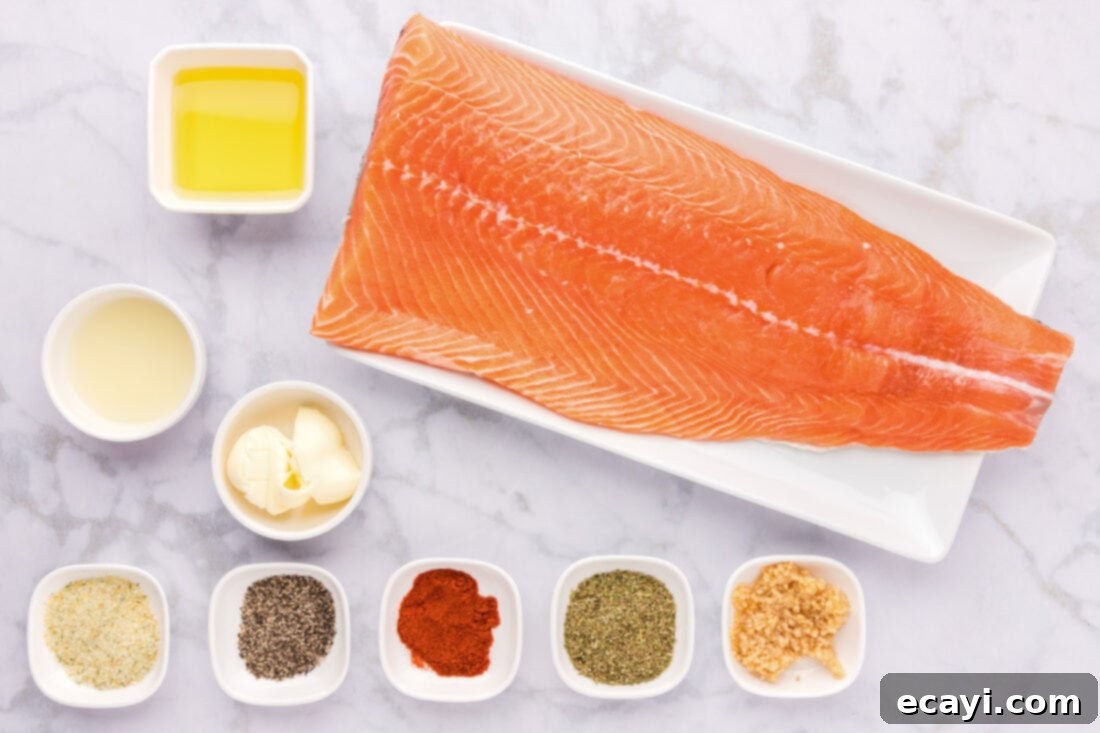
Ingredient Insights and Smart Substitutions
Understanding your ingredients is key to culinary success and flexibility. Here’s a deeper look into the components of this broiled salmon recipe:
SALMON SELECTION – This recipe is perfectly suited for a whole 2-pound center-cut salmon fillet, ideally with the skin on. Keeping the skin on not only helps the fish retain its shape and moisture during the high heat of broiling but also crisps up beautifully, adding a delicious textural contrast. While we prefer to cut the salmon into smaller fillets *after* broiling for maximum moisture retention, you can certainly cut it before if you wish. Just be sure to monitor smaller pieces closely under the broiler as they will cook faster. When choosing salmon, look for vibrant color, firm flesh, and a fresh, ocean scent. Atlantic, Sockeye, and Coho are all excellent choices, with varying fat content and flavor profiles. If using frozen salmon, ensure it’s fully thawed in the refrigerator overnight or under cold running water before cooking, and pat it thoroughly dry to prevent steaming and encourage crispiness.
FLAVORFUL MARINADE – Our recommended salmon marinade is a simple yet powerful blend designed to infuse your fish with incredible flavor and keep it tender. It consists of:
- Butter & Olive Oil: These fats not only carry flavor but also help achieve that desirable crispy skin and prevent the fish from drying out.
- Garlic Salt & Minced Garlic: For a robust, aromatic foundation. Fresh garlic offers a pungent kick, while garlic salt provides a balanced seasoning.
- Pepper: A classic seasoning to complement the other flavors.
- Italian Seasoning & Paprika: Italian seasoning adds an earthy, herbaceous depth, while paprika contributes a mild sweetness and a beautiful reddish hue, enhancing the visual appeal of the broiled salmon.
- Lemon Juice: Essential for brightening the flavors, lemon juice adds a touch of acidity that cuts through the richness of the salmon and tenderizes the flesh.
Marinating the salmon for about an hour allows these flavors to deeply penetrate the fish. However, if you’re short on time, a quick brush with the marinade or a simple seasoning of salt, freshly cracked black pepper, and a squeeze of lemon juice will still yield delicious results. Feel free to experiment with other seasonings like dill, onion powder, a dash of cayenne for a subtle kick, or even a teriyaki glaze for an Asian-inspired twist. The key is to enhance, not overpower, the natural taste of the salmon.
Step-by-Step: How to Make Perfect Broiled Salmon
These step-by-step photos and instructions are here to help you visualize how to make this recipe. You can Jump to Recipe to get the printable version of this recipe, complete with measurements and instructions at the bottom.
- Prepare the Salmon: Begin by patting your salmon fillet thoroughly dry with paper towels. This crucial step helps achieve crispy skin. Next, marinate the salmon using our recommended salmon marinade recipe for a minimum of one hour to allow the flavors to deepen. If time is limited, a quick rub with olive oil, salt, and pepper will also work wonderfully.

- Preheat the Broiler: Position an oven rack in the center of your oven. Turn on your oven’s broiler function and allow it to preheat for at least 5-10 minutes. This ensures the broiler element is scorching hot, ready to sear the salmon.
- Prepare the Baking Sheet: Line a baking sheet with aluminum foil for easier cleanup, then spray it generously with nonstick cooking spray. This prevents the delicate salmon skin from sticking.
- Arrange the Salmon: Carefully place the marinated salmon fillet, skin-side up, onto the prepared baking sheet. Ensure the salmon is not overcrowded if cooking multiple pieces, allowing for even cooking and crisping.

- Broil to Perfection: Place the baking sheet with the salmon into the preheated oven, with the rack in the center position. Broil for 10-13 minutes. Keep a close eye on the salmon, as broilers can vary in intensity. The skin should be golden brown and crispy, and the flesh opaque and flaky when done. Avoid flipping the salmon during broiling to maintain the crispy skin.


- Rest and Serve: Once broiled, remove the salmon from the oven and let it rest for 2-3 minutes. This allows the juices to redistribute, ensuring a moist and flavorful fillet. Then, slice the whole fillet into individual portions and serve immediately.
Frequently Asked Questions & Expert Tips for Broiled Salmon
Determining when salmon is perfectly cooked is crucial to avoid a dry or undercooked result. To test for doneness, gently press your finger (or the tip of a knife if it’s too hot) onto the top center or thickest part of the salmon. If it easily begins to flake or separate, it is done. The flesh should also appear opaque throughout. If you overcook the salmon, it will become dry and overly flaky. For precision, you may also use an instant-read thermometer. Salmon is typically considered medium when it reaches an internal temperature of 125-135°F (52-57°C) in the thickest part of the fillet. For well-done, aim for 140-145°F (60-63°C). Insert the thermometer horizontally into the thickest part to get an accurate reading.
To maintain freshness and flavor, store any leftover broiled salmon in an air-tight container in the refrigerator for 2-3 days. When reheating, it’s best to do so gently to prevent it from drying out. Place the salmon in a preheated 275°F (135°C) oven for 10-15 minutes, or until it is warmed through. You can also gently warm it in a microwave on a low setting, covered, for short bursts, but the oven method is preferred for retaining moisture.
Expert Tips for the Best Broiled Salmon:
- Pat It Dry: This cannot be stressed enough. A dry surface is essential for crispy skin. Moisture on the salmon will cause it to steam rather than crisp.
- High Heat is Your Friend: Broiling relies on intense heat. Ensure your broiler is fully preheated for at least 5-10 minutes before placing the salmon inside.
- Mind the Rack Position: For extra crispy skin, position the oven rack closer to the broiler element (e.g., 4-6 inches away). For a more even cook and slightly less intense crisping, the center rack is perfect.
- Don’t Overcrowd: If cooking multiple fillets, give them space on the baking sheet. Overcrowding can lower the temperature and lead to steaming.
- Watch Closely: Broilers can cook very quickly, and intensity varies by oven. Never walk away from broiling salmon. Keep an eye on it to prevent burning.
- Rest the Salmon: After removing from the oven, let the salmon rest for a few minutes. This allows the juices to redistribute, resulting in a more tender and moist fillet.
- Healthy & Delicious: Salmon is a powerhouse of nutrition, rich in Omega-3 fatty acids, which are great for heart and brain health. Enjoying it broiled is a fantastic way to prepare it while keeping it lean and flavorful.
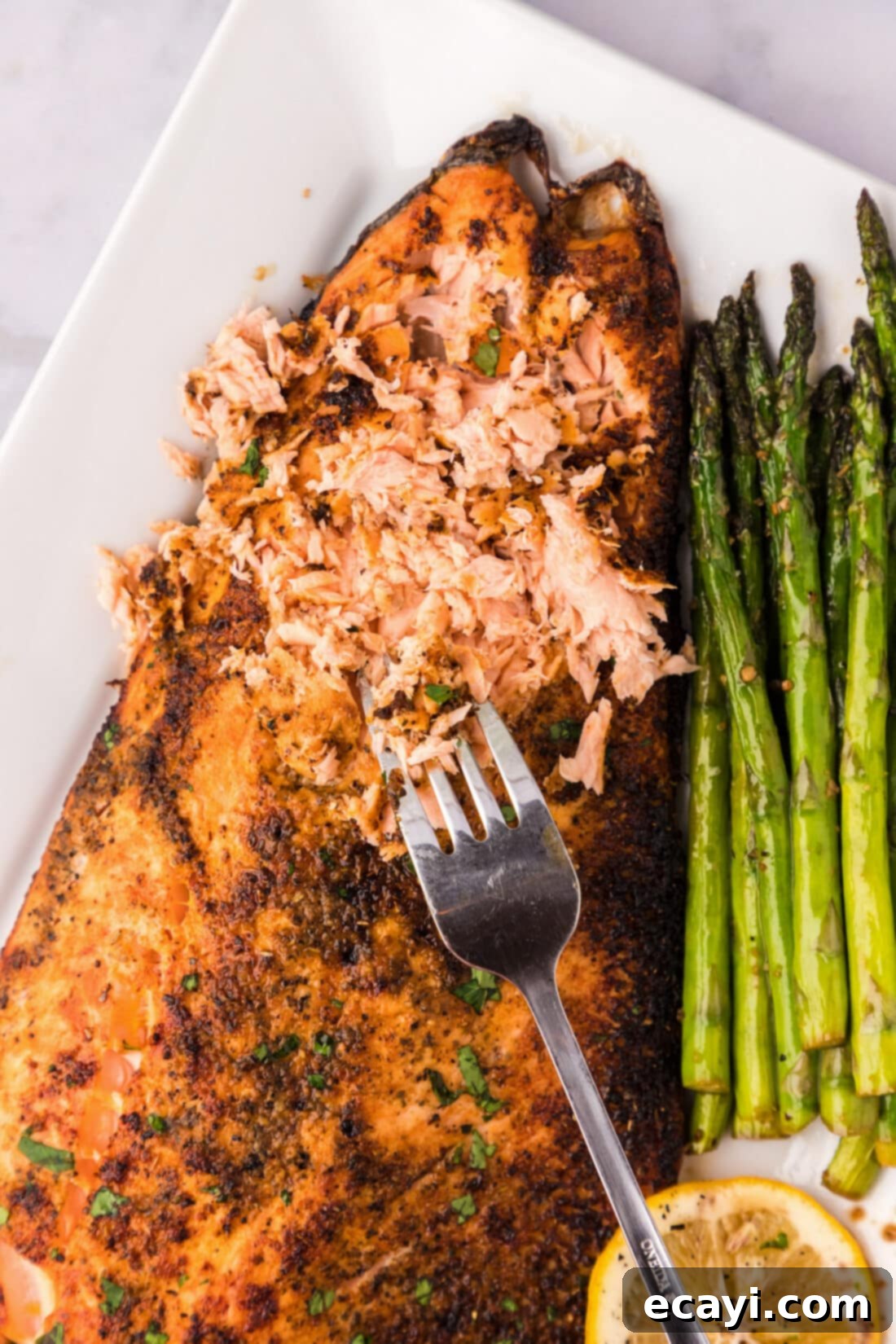
Delicious Serving Suggestions for Broiled Salmon
Broiled salmon is incredibly versatile and pairs wonderfully with a wide array of side dishes. For a complete and satisfying meal, consider serving it with classic accompaniments like roasted red potatoes and roasted asparagus, as we frequently do. The earthy flavors and textures beautifully complement the rich salmon.
However, the possibilities are endless! You could also opt for a fluffy side of rice, wholesome baked potatoes, or a vibrant lemon couscous. Steamed or sautéed vegetables such as broccoli, carrots, green beans, or even a fresh garden salad with a light vinaigrette make excellent choices for a lighter meal. For an extra touch of flavor and visual appeal, garnish your broiled salmon with fresh dill, parsley, or a few thin slices of lemon before serving. Enjoy this delicious and healthy meal warm, perhaps with a dollop of a creamy dill sauce or a bright lemon-butter sauce to truly elevate the experience.
Explore More Ways To Cook Salmon
While broiling offers an exceptional way to enjoy salmon, there are many other fantastic methods to explore, each yielding unique textures and flavors:
- Grilled Salmon
- Roasted Salmon
- Poached Salmon
- Air Fryer Salmon
- Sous Vide Salmon
- Instant Pot Salmon
Each method brings out different qualities of this versatile fish, offering a world of culinary possibilities.
I genuinely love to bake and cook, and it brings me joy to share my kitchen experiences with all of you! Remembering to come back each day for new recipes can be tough, which is why I offer a convenient newsletter every time a new recipe posts. Simply subscribe today and start receiving your free daily recipes directly to your inbox!
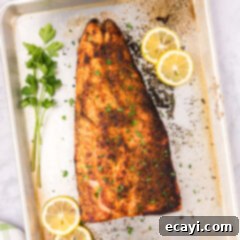
Broiled Salmon
IMPORTANT – There are often Frequently Asked Questions within the blog post that you may find helpful. Simply scroll back up to read them!
Print It
Pin It
Rate It
Save ItSaved!
Ingredients
- 2 pounds center cut salmon (skin-on recommended, patted dry)
- 1 recipe Salmon Marinade or simply season with salt, pepper, and a squeeze of lemon juice
Equipment You’ll Need
-
Baking sheet
-
Vinyl gloves
-
Instant-read thermometer
Before You Begin & Pro Tips
- Nutrition facts provided do not include the marinade, as its absorption can vary.
- Instead of our specific marinade, feel free to season the salmon however you prefer. A simple combination of salt, black pepper, and fresh lemon juice works wonderfully. If you skip the marinade, you can reduce the total preparation time by one hour.
- Always pat your salmon thoroughly dry with paper towels before seasoning or marinating. This is key to achieving that desirable crispy skin under the broiler.
- Store any leftover broiled salmon in an air-tight container in the refrigerator for 2-3 days. To reheat, place it in a 275°F (135°C) oven for 10-15 minutes, or until it’s warmed through to prevent drying out.
- Keep a close eye on your salmon while it’s under the broiler, as cook times can vary greatly depending on your oven and the thickness of your fish.
Instructions
-
Pat the salmon fillet dry. Marinate the salmon using our salmon marinade recipe for one hour, or season however you’d like (e.g., salt, pepper, lemon juice).
-
Preheat oven to the broil function. Allow it to heat for at least 5-10 minutes.
-
Line a baking sheet with foil and spray with nonstick cooking spray.
-
Place the marinated salmon, skin-side up, on the prepared baking sheet.
-
Place the oven rack in the center position (or slightly higher for crispier skin, closer to 4-6 inches from the broiler).
-
Place the baking sheet in the oven and broil for 10-13 minutes, or until the skin is golden and crispy, and the flesh is opaque and flakes easily. Remove from oven and slice into 4 filets after a brief rest.
Nutrition Information (Estimated)
The recipes on this blog are tested with a conventional gas oven and gas stovetop. It’s important to note that some ovens, especially as they age, can cook and bake inconsistently. Using an inexpensive oven thermometer can assure you that your oven is truly heating to the proper temperature. If you use a toaster oven or countertop oven, please keep in mind that they may not distribute heat the same as a conventional full sized oven and you may need to adjust your cooking/baking times. In the case of recipes made with a pressure cooker, air fryer, slow cooker, or other appliance, a link to the appliances we use is listed within each respective recipe. For baking recipes where measurements are given by weight, please note that results may not be the same if cups are used instead, and we can’t guarantee success with that method.
